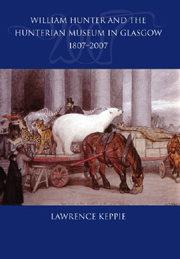Book contents
- Frontmatter
- Contents
- Foreword by Sir Kenneth Calman
- Introduction
- List of Illustrations
- Acknowledgements
- Abbreviations used in the Notes
- Dedication
- 1 William Hunter's Life and Career
- 2 Growth of the Hunterian Collection
- 3 ‘The Noblest Legacy upon Record’
- 4 A Temple of the Muses: the First Hunterian Museum in Glasgow
- 5 ‘This Place of Fascination’: the Impact of the Museum, 1807–70
- 6 A New Museum for a New University, 1870–1900
- 7 The Twentieth Century: War, Peace and Renewal, 1900–75
- 8 The Hunterian Art Gallery
- 9 Modern Times, 1975–2007
- 10 Overview: Meeting William Hunter's Intentions
- Postscript: Looking to the Future
- Notes
- Appendix: Catalogues of the Hunterian Collections
- Bibliography
- Index
- Plate section
8 - The Hunterian Art Gallery
Published online by Cambridge University Press: 12 September 2012
- Frontmatter
- Contents
- Foreword by Sir Kenneth Calman
- Introduction
- List of Illustrations
- Acknowledgements
- Abbreviations used in the Notes
- Dedication
- 1 William Hunter's Life and Career
- 2 Growth of the Hunterian Collection
- 3 ‘The Noblest Legacy upon Record’
- 4 A Temple of the Muses: the First Hunterian Museum in Glasgow
- 5 ‘This Place of Fascination’: the Impact of the Museum, 1807–70
- 6 A New Museum for a New University, 1870–1900
- 7 The Twentieth Century: War, Peace and Renewal, 1900–75
- 8 The Hunterian Art Gallery
- 9 Modern Times, 1975–2007
- 10 Overview: Meeting William Hunter's Intentions
- Postscript: Looking to the Future
- Notes
- Appendix: Catalogues of the Hunterian Collections
- Bibliography
- Index
- Plate section
Summary
Growth of the art collections: Whistler and Mackintosh
Paintings and prints had constituted a minor element in William Hunter's overall collections (see p. 21). However, from our presentday perspective we can in particular applaud his acquisition of three outstanding paintings by his contemporary J. B. S. Chardin, together with Rembrandt's Entombment, Philips Koninck's Landscape in Holland, three animal paintings by George Stubbs, together with his own portrait commissioned from Allan Ramsay. In 1807 the Hunterian pictures were placed in the new Museum's Picture Gallery (see p. 59), and in other locations within the building. The College itself continued to display pictures, particularly of its own rectors, principals, professors, benefactors and other luminaries, in various public rooms, for example in the Fore Hall, in classrooms and (later) in departments, a practice which continues to this day.
In 1870 the Hunterian paintings and prints were transferred to Gilmorehill, and displayed either in the Library or in the adjacent Anteroom, in conditions of increased congestion, hung from floor to ceiling, after the fashion of the time. Though at first we hear little about them, their conservation needs were not ignored, and repairs and reframing took place at intervals. A report commissioned in 1931–2 from Stanley Cursiter, then Director of the National Portrait Gallery in Edinburgh, provides a useful digest of the location of individual paintings which were split between the Library and the ‘Hunterian Parlour’ [the Ante-room]; he had the use of a stepladder to examine them.
- Type
- Chapter
- Information
- William Hunter and the Hunterian Museum in Glasgow 1807–2007 , pp. 106 - 114Publisher: Edinburgh University PressPrint publication year: 2007



